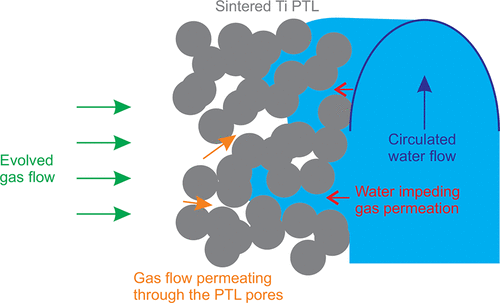当前位置:
X-MOL 学术
›
ACS Sustain. Chem. Eng.
›
论文详情
Our official English website, www.x-mol.net, welcomes your feedback! (Note: you will need to create a separate account there.)
Understanding the Role of Water Flow and the Porous Transport Layer on the Performance of Proton Exchange Membrane Water Electrolyzers
ACS Sustainable Chemistry & Engineering ( IF 8.4 ) Pub Date : 2018-12-10 00:00:00 , DOI: 10.1021/acssuschemeng.8b05369 J. Garcia-Navarro 1 , M. Schulze 1 , K. A. Friedrich 1, 2
ACS Sustainable Chemistry & Engineering ( IF 8.4 ) Pub Date : 2018-12-10 00:00:00 , DOI: 10.1021/acssuschemeng.8b05369 J. Garcia-Navarro 1 , M. Schulze 1 , K. A. Friedrich 1, 2
Affiliation

|
In this article, we have brought a different perspective to the topic of mass transport losses in a proton exchange membrane (PEM) water electrolyzer, particularly regarding the role of water flow and the dominant mass transport mechanism in the porous transport layer (PTL). We conducted permeation experiments on a sintered Ti PTL, where we measured the pressure loss of gas that flows through its pores; furthermore, we presented a model based on the van Genuchten–Mualem capillary pressure and the Carman–Kozeny gas permeability, and we report an increase in the pressure loss with respect to the water flow, which we reported as an increase in the apparent tortuosity of the pores in the PTL. From this we conclude that the water flow exerts a shear stress on the gas flowing through the PTL, proportional to its kinetic energy, and that the gas permeation is the dominant transport mechanism within a PTL, in contrast to a one- or two-phase flow, which is more energy demanding. Finally, we propose that further work be carried out, in particular by comparing these results to in situ measurements on an operating PEM electrolyzer.
中文翻译:

了解水流和多孔传输层对质子交换膜水电解槽性能的影响
在本文中,我们对质子交换膜(PEM)水电解槽中的传质损失问题提出了不同的看法,尤其是关于水流的作用和多孔传输层(PTL)中占主导地位的传质机理。我们在一个烧结的Ti PTL上进行了渗透实验,在该实验中,我们测量了流经其孔隙的气体的压力损失。此外,我们提出了基于范Genuchten-Mualem毛细压力和Carman-Kozeny气体渗透率的模型,并且我们报告了相对于水流的压力损失增加,我们认为这是由于水的表观曲折度增加所致。 PTL中的毛孔。由此得出的结论是,水流会对流经PTL的气体施加剪切应力,与它的动能成正比,并且与一相或两相流相比,气体渗透是PTL内的主要传输机制,这对能量的需求更大。最后,我们建议进行进一步的工作,特别是将这些结果与正在运行的PEM电解器上的原位测量结果进行比较。
更新日期:2018-12-10
中文翻译:

了解水流和多孔传输层对质子交换膜水电解槽性能的影响
在本文中,我们对质子交换膜(PEM)水电解槽中的传质损失问题提出了不同的看法,尤其是关于水流的作用和多孔传输层(PTL)中占主导地位的传质机理。我们在一个烧结的Ti PTL上进行了渗透实验,在该实验中,我们测量了流经其孔隙的气体的压力损失。此外,我们提出了基于范Genuchten-Mualem毛细压力和Carman-Kozeny气体渗透率的模型,并且我们报告了相对于水流的压力损失增加,我们认为这是由于水的表观曲折度增加所致。 PTL中的毛孔。由此得出的结论是,水流会对流经PTL的气体施加剪切应力,与它的动能成正比,并且与一相或两相流相比,气体渗透是PTL内的主要传输机制,这对能量的需求更大。最后,我们建议进行进一步的工作,特别是将这些结果与正在运行的PEM电解器上的原位测量结果进行比较。



























 京公网安备 11010802027423号
京公网安备 11010802027423号